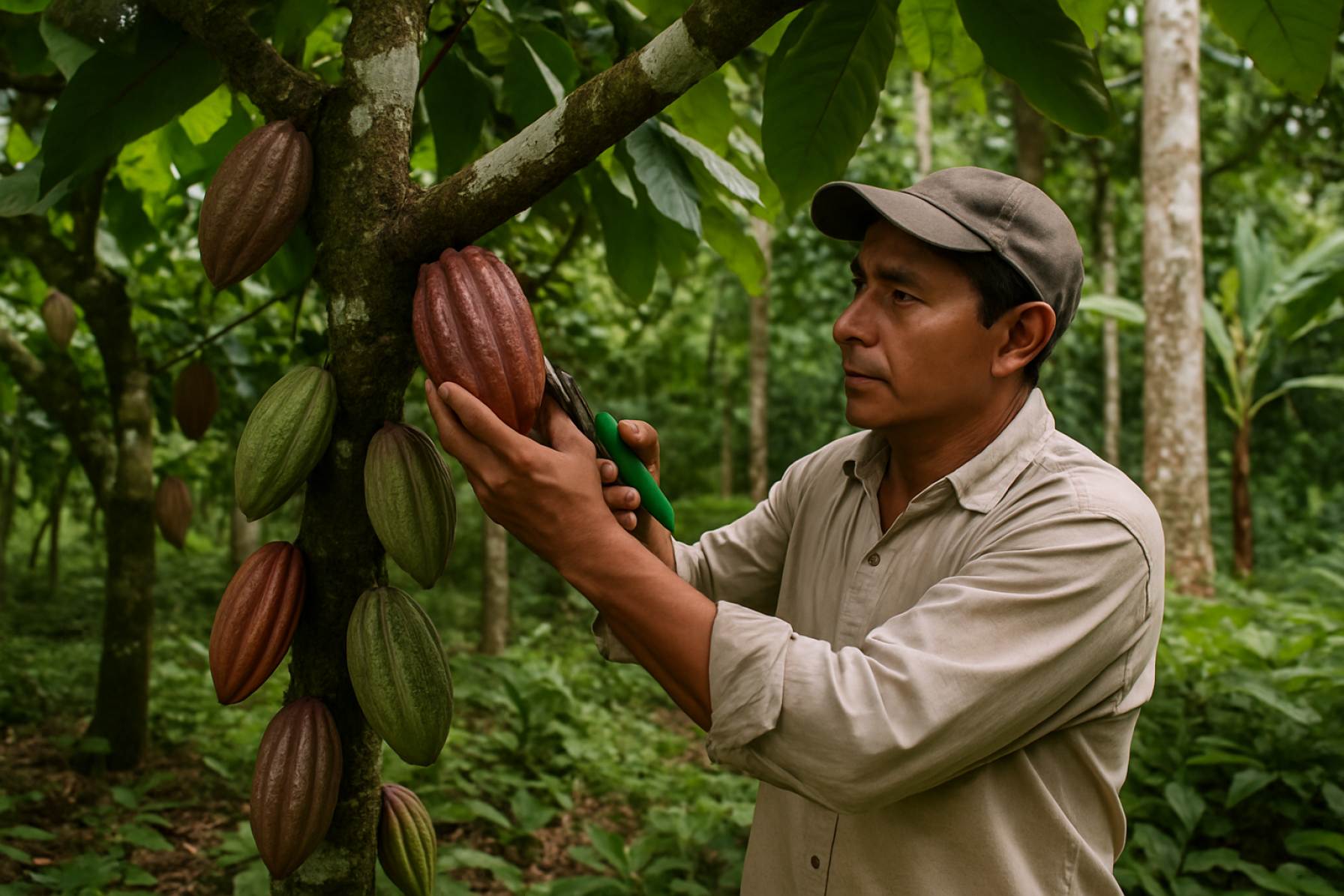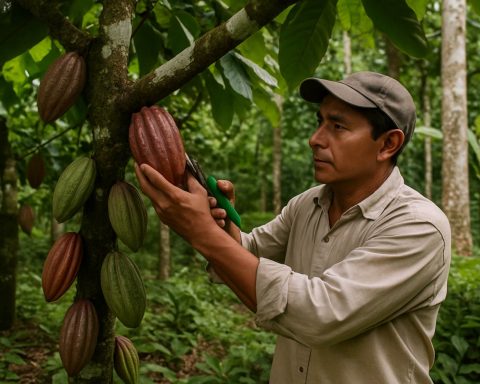Transforming Chocolate Production: How Cacao Agroforestry Systems Drive Sustainability, Boost Farmer Incomes, and Restore Ecosystems. Discover the Future of Ethical Cacao Cultivation.
- Introduction to Cacao Agroforestry Systems
- Historical Context and Evolution of Cacao Cultivation
- Key Components and Design Principles
- Ecological Benefits: Biodiversity, Soil Health, and Climate Resilience
- Socioeconomic Impacts on Farming Communities
- Comparing Agroforestry and Monoculture Cacao Systems
- Challenges and Barriers to Adoption
- Case Studies: Successful Cacao Agroforestry Models Worldwide
- Best Practices and Recommendations for Implementation
- Future Outlook: Innovations and Policy Support
- Sources & References
Introduction to Cacao Agroforestry Systems
Cacao agroforestry systems are integrated land-use practices where cacao (Theobroma cacao) is cultivated alongside a diverse array of trees, shrubs, and sometimes crops or livestock. This approach contrasts with monoculture plantations, offering a more ecologically sustainable and socially beneficial model for cacao production. Agroforestry systems mimic natural forest structures, providing shade for cacao trees, enhancing biodiversity, and supporting ecosystem services such as soil fertility, water regulation, and carbon sequestration. These systems are particularly prevalent in tropical regions of West Africa, Latin America, and Southeast Asia, where smallholder farmers rely on cacao as a primary source of income.
The adoption of cacao agroforestry systems addresses several challenges associated with conventional cacao farming, including deforestation, soil degradation, and vulnerability to pests and diseases. By incorporating native and economically valuable tree species, farmers can diversify their income streams and reduce economic risks. Additionally, agroforestry systems contribute to climate change mitigation by storing more carbon than monocultures and providing habitats for wildlife, including pollinators and natural pest predators. Research has shown that well-managed cacao agroforestry systems can maintain or even enhance yields while promoting long-term sustainability and resilience in the face of environmental change (Food and Agriculture Organization of the United Nations).
As global demand for sustainable and ethically produced chocolate grows, cacao agroforestry systems are increasingly recognized by governments, NGOs, and the private sector as a viable pathway to balance productivity, environmental conservation, and rural livelihoods (World Cocoa Foundation). Ongoing research and policy support are essential to optimize these systems and ensure their widespread adoption.
Historical Context and Evolution of Cacao Cultivation
Cacao agroforestry systems have deep historical roots, tracing back to pre-Columbian Mesoamerica, where indigenous peoples cultivated Theobroma cacao under the shade of native forest trees. This traditional practice was not only a means of food production but also a method of maintaining ecological balance and cultural identity. The Spanish colonization in the 16th century marked a significant shift, as cacao cultivation expanded to meet European demand, leading to the establishment of large plantations and, in some regions, the replacement of diverse agroforestry systems with monocultures Food and Agriculture Organization of the United Nations.
Throughout the 19th and 20th centuries, the intensification of cacao production, driven by global market forces, often prioritized yield over sustainability. This resulted in widespread deforestation and biodiversity loss, particularly in West Africa and Latin America. However, the resilience of traditional agroforestry systems persisted in many smallholder communities, where cacao continued to be grown alongside timber, fruit trees, and other crops, providing multiple ecosystem services and diversified income streams World Cocoa Foundation.
In recent decades, there has been a renewed recognition of the ecological and socio-economic benefits of cacao agroforestry. Modern approaches increasingly integrate scientific knowledge with traditional practices, aiming to restore degraded landscapes, enhance climate resilience, and support smallholder livelihoods. This evolution reflects a broader shift towards sustainable agriculture, positioning cacao agroforestry as a key strategy for balancing productivity with environmental stewardship Center for International Forestry Research (CIFOR).
Key Components and Design Principles
Cacao agroforestry systems are characterized by the deliberate integration of cacao trees (Theobroma cacao) with a diverse array of shade trees, crops, and sometimes livestock, creating a multifunctional landscape. The key components of these systems include the cacao trees themselves, shade-providing species (such as leguminous trees, fruit trees, and timber species), ground cover plants, and, in some cases, additional cash or subsistence crops. The selection of shade trees is critical, as they regulate microclimate, enhance soil fertility through nitrogen fixation or organic matter input, and provide habitat for beneficial fauna. Commonly used shade species include Inga spp., Gliricidia sepium, and various native fruit trees, which can also offer additional income streams or food security for farmers (World Cocoa Foundation).
Design principles for cacao agroforestry systems emphasize spatial and temporal diversity. Spatial arrangement involves optimizing tree density and species composition to balance light availability, disease management, and resource competition. Temporal diversity is achieved by incorporating species with different growth rates and life spans, ensuring continuous canopy cover and resource cycling. Effective design also considers local ecological conditions, such as rainfall, soil type, and topography, to maximize resilience and productivity. Adaptive management, including periodic pruning, selective thinning, and enrichment planting, is essential to maintain system health and productivity over time (Food and Agriculture Organization of the United Nations). By integrating ecological and socioeconomic objectives, well-designed cacao agroforestry systems can enhance biodiversity, improve livelihoods, and contribute to climate change mitigation.
Ecological Benefits: Biodiversity, Soil Health, and Climate Resilience
Cacao agroforestry systems offer significant ecological benefits, particularly in terms of biodiversity conservation, soil health improvement, and climate resilience. By integrating cacao trees with a diverse array of shade trees, shrubs, and ground cover, these systems create complex habitats that support a wide range of flora and fauna. Studies have shown that cacao agroforestry can maintain higher levels of plant, bird, and insect diversity compared to monoculture plantations, thereby contributing to the preservation of threatened species and the overall ecological integrity of tropical landscapes (Center for International Forestry Research).
Soil health is another critical benefit of cacao agroforestry. The presence of multiple plant species enhances organic matter input through leaf litter and root turnover, which improves soil structure, fertility, and microbial activity. Shade trees help regulate soil temperature and moisture, reducing erosion and nutrient leaching. These processes collectively foster a more resilient and productive soil ecosystem, which is essential for sustainable cacao production (Food and Agriculture Organization of the United Nations).
In terms of climate resilience, cacao agroforestry systems sequester carbon both above and below ground, mitigating greenhouse gas emissions. The diversified canopy buffers cacao plants against extreme weather events, such as droughts and heavy rainfall, by moderating microclimatic conditions. This resilience is increasingly important as climate change poses new challenges to tropical agriculture (World Cocoa Foundation). Collectively, these ecological benefits highlight the value of agroforestry as a sustainable approach to cacao cultivation.
Socioeconomic Impacts on Farming Communities
Cacao agroforestry systems have significant socioeconomic impacts on farming communities, particularly in tropical regions where cacao is a primary cash crop. By integrating cacao with shade trees and other crops, these systems diversify farmers’ income sources, reducing economic vulnerability to market fluctuations and crop failures. Studies have shown that agroforestry can increase household income stability by allowing farmers to harvest and sell a variety of products, such as timber, fruits, and medicinal plants, alongside cacao beans (World Cocoa Foundation).
Moreover, cacao agroforestry systems often require less chemical input compared to monoculture plantations, lowering production costs and health risks for farming families. The presence of shade trees can also improve microclimatic conditions, leading to better cacao yields and quality, which can command higher prices in specialty markets (Food and Agriculture Organization of the United Nations). Additionally, these systems foster community resilience by promoting knowledge exchange and collective management practices, often supported by cooperatives and certification schemes.
However, the transition to agroforestry can present challenges, such as the need for initial investment, technical training, and access to markets for diversified products. Support from governmental and non-governmental organizations is crucial to address these barriers and ensure equitable benefits for smallholder farmers (International Cocoa Organization). Overall, cacao agroforestry systems offer a pathway to improved livelihoods, social cohesion, and long-term sustainability for farming communities.
Comparing Agroforestry and Monoculture Cacao Systems
Comparing agroforestry and monoculture cacao systems reveals significant differences in ecological, economic, and social outcomes. Agroforestry systems integrate cacao with a diversity of shade trees and other crops, fostering greater biodiversity and ecosystem services. These systems support pollinators, natural pest predators, and soil health, leading to more resilient production landscapes. In contrast, monoculture cacao plantations, characterized by dense planting of a single species with minimal shade, often result in reduced biodiversity, increased vulnerability to pests and diseases, and greater reliance on chemical inputs Food and Agriculture Organization of the United Nations.
Economically, agroforestry systems can provide diversified income streams for farmers through the sale of timber, fruit, and other non-cacao products, buffering against fluctuations in cacao prices. While monoculture systems may offer higher short-term yields due to intensive management, they are more susceptible to market and climate risks. Studies have shown that agroforestry cacao can maintain competitive yields over time, especially as trees mature and microclimatic conditions improve World Cocoa Foundation.
Socially, agroforestry systems often align better with traditional farming practices and local knowledge, supporting food security and community resilience. They also contribute to climate change mitigation by sequestering carbon and conserving soil and water resources. In summary, while monoculture cacao may offer short-term productivity gains, agroforestry systems provide a more sustainable and resilient approach to cacao cultivation, balancing productivity with environmental and social benefits Center for International Forestry Research.
Challenges and Barriers to Adoption
Despite the ecological and economic benefits of cacao agroforestry systems, their widespread adoption faces several significant challenges. One major barrier is the limited access to technical knowledge and extension services among smallholder farmers. Many producers lack information on optimal agroforestry design, species selection, and management practices, which can hinder productivity and profitability. Additionally, the initial costs of establishing agroforestry systems—such as purchasing seedlings and modifying existing plots—can be prohibitive, especially for resource-constrained farmers who may not have access to credit or financial incentives (Food and Agriculture Organization of the United Nations).
Market-related challenges also play a critical role. Agroforestry products, including shade-grown cacao, often do not receive price premiums that reflect their environmental benefits, reducing the financial motivation for farmers to transition from monoculture systems. Furthermore, insecure land tenure and unclear property rights can discourage long-term investments in agroforestry, as farmers may fear losing access to land before reaping the benefits of their efforts (World Bank).
Finally, policy and institutional barriers persist. In some regions, agricultural policies and subsidies still favor monoculture or conventional farming practices, while regulatory frameworks may restrict the integration of trees on agricultural land. Overcoming these challenges requires coordinated efforts among governments, NGOs, and the private sector to provide technical support, financial incentives, secure land rights, and market recognition for sustainable cacao agroforestry systems (Center for International Forestry Research).
Case Studies: Successful Cacao Agroforestry Models Worldwide
Several successful cacao agroforestry models worldwide demonstrate the potential of integrating cacao cultivation with diverse tree species to achieve both ecological and economic benefits. In Latin America, the Tropical Agricultural Research and Higher Education Center (CATIE) has documented multi-strata systems in Costa Rica, where cacao is grown alongside timber trees, fruit crops, and nitrogen-fixing species. These systems enhance biodiversity, improve soil fertility, and provide farmers with diversified income streams. Similarly, in Ghana, the Center for International Forestry Research (CIFOR) has reported on farmer-managed shade cacao systems that incorporate native trees, which help conserve local flora and fauna while maintaining stable cacao yields.
In Indonesia, the World Agroforestry (ICRAF) has supported the development of cacao agroforestry models that combine cacao with coconut, banana, and leguminous trees. These models have proven effective in reducing pest outbreaks and increasing resilience to climate variability. In Brazil, the “Cabruca” system in Bahia integrates cacao under the shade of Atlantic Forest trees, preserving significant forest cover and supporting wildlife corridors, as recognized by the Food and Agriculture Organization of the United Nations (FAO).
These case studies highlight that successful cacao agroforestry models are context-specific, adapting to local ecological conditions and farmer needs. They collectively demonstrate that agroforestry can be a viable strategy for sustainable cacao production, balancing productivity with conservation and rural livelihoods.
Best Practices and Recommendations for Implementation
Implementing cacao agroforestry systems effectively requires a combination of ecological, agronomic, and socio-economic best practices. One key recommendation is the careful selection of shade tree species, prioritizing native and multipurpose trees that enhance biodiversity, provide ecosystem services, and offer additional income sources such as timber, fruits, or medicinal products. Integrating nitrogen-fixing species can improve soil fertility and reduce the need for synthetic fertilizers, supporting long-term productivity and sustainability (World Cocoa Foundation).
Spatial arrangement and density of both cacao and shade trees should be tailored to local conditions, balancing light requirements for optimal cacao growth with the benefits of shade for microclimate regulation and pest management. Regular pruning and maintenance of shade trees are essential to prevent excessive competition and to facilitate air circulation, which helps reduce disease incidence (Alliance of Bioversity International and CIAT).
Soil health management is another critical aspect, involving organic mulching, cover cropping, and minimal tillage to maintain soil structure and moisture. Integrated pest management (IPM) strategies, combining biological controls and cultural practices, are recommended to minimize chemical inputs and promote ecological balance (Food and Agriculture Organization of the United Nations).
Finally, successful implementation depends on farmer training, access to technical support, and the development of market linkages for diversified products. Participatory approaches that involve local communities in planning and decision-making foster ownership and long-term adoption of agroforestry practices (Rainforest Alliance).
Future Outlook: Innovations and Policy Support
The future of cacao agroforestry systems is shaped by a convergence of technological innovation, climate adaptation strategies, and evolving policy frameworks. Precision agriculture tools, such as remote sensing and mobile-based farm management platforms, are increasingly accessible to smallholder cacao farmers, enabling more efficient monitoring of tree health, soil conditions, and shade management. These innovations can optimize yields while maintaining the ecological benefits of agroforestry, such as biodiversity conservation and carbon sequestration (World Cocoa Foundation).
Climate change poses significant challenges to cacao production, including increased pest pressures and shifting suitable growing zones. Research into climate-resilient cacao varieties and diversified shade tree species is underway, aiming to bolster system resilience and farmer livelihoods. Integrating native and economically valuable trees can further enhance ecosystem services and income diversification (Center for International Forestry Research (CIFOR)).
Policy support is critical for scaling up sustainable cacao agroforestry. Governments and international organizations are developing certification schemes, financial incentives, and technical assistance programs to encourage adoption. The European Union’s new regulations on deforestation-free supply chains, for example, are expected to drive greater investment in traceable, sustainable cacao production (European Commission). Collaborative efforts between public, private, and civil society actors will be essential to ensure that innovations and policies are inclusive, benefiting smallholders and promoting long-term sustainability in cacao landscapes.
Sources & References
- Food and Agriculture Organization of the United Nations
- World Cocoa Foundation
- Center for International Forestry Research (CIFOR)
- International Cocoa Organization
- World Bank
- Tropical Agricultural Research and Higher Education Center (CATIE)
- World Agroforestry (ICRAF)
- Rainforest Alliance
- European Commission











